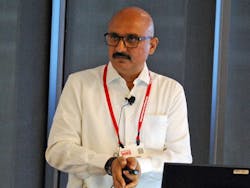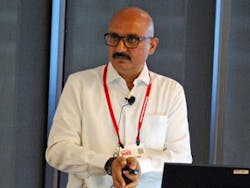“Don’t just automate the paper process—can you achieve compliance and efficiency at a cost savings?” Prashant Sharma of Cadila Healthcare Ltd. discussed the company’s move to electronic batch record-keeping to comply with regulations but improve quality and productivity as well.
“We needed to improve data integrity by eliminating missing data and transcription errors,” began Prashant Sharma, president, global formulations manufacturing & operations, Cadila Healthcare Ltd. (Zydus), to attendees of his session at the Rockwell Automation TechED event this week in San Diego. “We needed to eliminate paper in manufacturing, which ran 700 pages per batch with 15 entries per page.”
Cadila is a fully integrated pharmaceutical manufacturing company with $1.5 billion in sales, 50% to the U.S., the balance to India and emerging countries. It has 20,000 employees around the world, and is a Partner of Choice for major pharmaceutical companies including Abbott, Hospira, Bayer, Takeda, IDRI, Pieris AG, Prolong Pharmaceuticals and the World Health Organization.
The company wanted to develop a “build on and beyond” compliance approach and also launch its electronic batch recording (eBR) journey, so it sought a manufacturing execution system (MES) solution that would improve data integrity, eliminate manual and paper recording, and help reduce compliance risk.
Batch data often looked “too good, because exceptions were not highlighted,” Sharma said. As a result, batch audits were lengthy and arduous. “We needed automatic batch recording and documentation, and enforcement of the process, material flow, equipment rules and quality checks,” he said.
It takes more than a system
“Choosing a system is like buying a Ferrari because you want to win races,” Sharma said. “Having a Ferrari doesn’t mean you will win a race. You may need one to win, but winning takes more.”
Realize that one of the important roles of the automation partner you choose is education, Sharma said. “You don’t always know what to ask for because you don’t know everything you really need. Find a partner that has experience in your application and understands that they need to achieve results, not just the specification.”
After a two-year effort to define requirements and evaluate potential suppliers, Cadila found no Indian companies with the right experience. It decided on Rockwell Software PharmaSuite, as it provided the best solution fit, as well as a strong local presence, domain and technical expertise.
“It’s on the third party, in our case, Rockwell, to sell the right capabilities,” Sharma said.
Implementation challenges
Along with a long list of challenges due to integration with multiple OEMs’ hardware and systems, moving from paper to digital can present unexpected problems.
Sharma recommends that quality assurance (QA) personnel and auditors be involved early in the process. “QA may not be interested in helping you fix problems later, so involve them up front,” he said. “We showed the system to the auditors, and they pushed back on how easy it would be to do reviews. Design a system that will be both QA- and auditor-friendly.”
Also involve the operators. “This is where most operations go wrong,” Sharma said. “Senior people create, and operators only come in at the end. If not well trained, you have hiccups and long implementation times.
“Extend training a month or two after the project goes live. After the operators ‘get their hands dirty,’ they will be more focused and learn better, so do a refresher training.”
Don’t expect immediate improvements. “Some processes will take longer because interlocks don’t allow skipped steps,” Sharma said.
Beyond compliance
Compliance was achieved through the checks and balances built into the system, solid data integrity, and completeness in the review process. But “don’t just focus on compliance,” Sharma said. “Quality is larger than compliance.”
Furthermore, the industry is experiencing “huge pressure on margins due to India price controls, which are being considered in the U.S.,” Sharma added. “So also focus on productivity. Begin with quality, proceed to cost efficiencies, and let compliance be an expected consequence of the system.”
“Eliminate paper and the manual processes, but also any unnecessary steps,” Sharma said. “Don’t just automate the paper process—can you achieve compliance and efficiency at a cost savings?”
For example, by having the correct batch ID and record, “We can estimate yield as the batch progresses and adjust the coating and packaging requirements before materials are pulled from inventory,” Sharma said. “If a full batch will not be available, don’t dispense materials that will be wasted.”
Use the system to educate operators—teach them why times, temperatures and other parameters are important. “Make sure the operator understands why, when a process has a maximum temperature of 60 °C and hits 61 °C, writing down 59 °C doesn’t save the batch,” Sharma said. “If the operators don’t understand, you won’t get acceptance on the floor.
“If you focus on quality, throughput will improve, and the system should help you to find the golden batch and repeat it.”
The new system is also speeding recipe management. “We are launching 300 products per year, so we must turn around recipes quickly,” Sharma said. “We got 80 approvals last year, so there’s pressure to launch product in three to four days flat.
“We’re looking at IoT and Industrie 4.0, but there are so many vendors,” Sharma said. “And if anything is a problem, they point fingers, they don’t want to talk to each other. So for now, we’re trying to perfect one plant before rolling it out.”
About the Author
Paul Studebaker
Paul Studebaker

Leaders relevant to this article:


